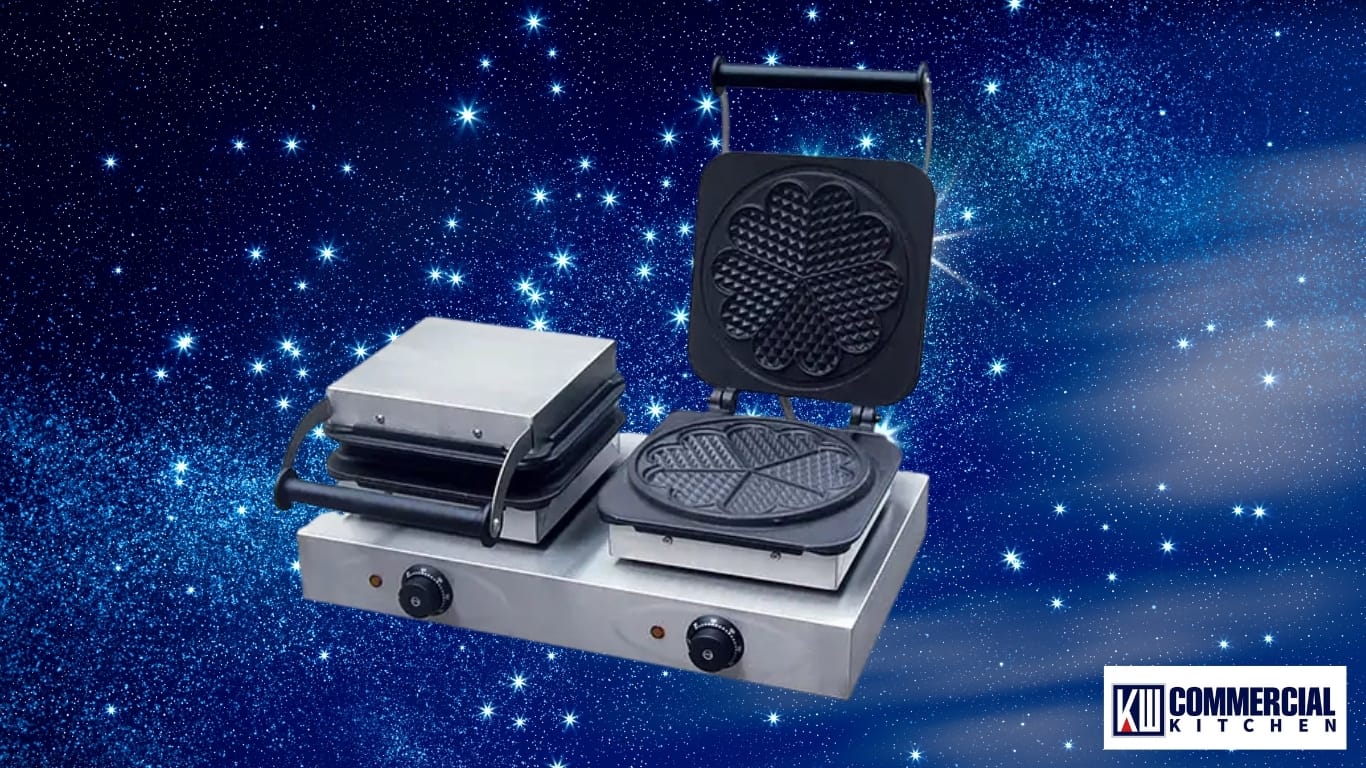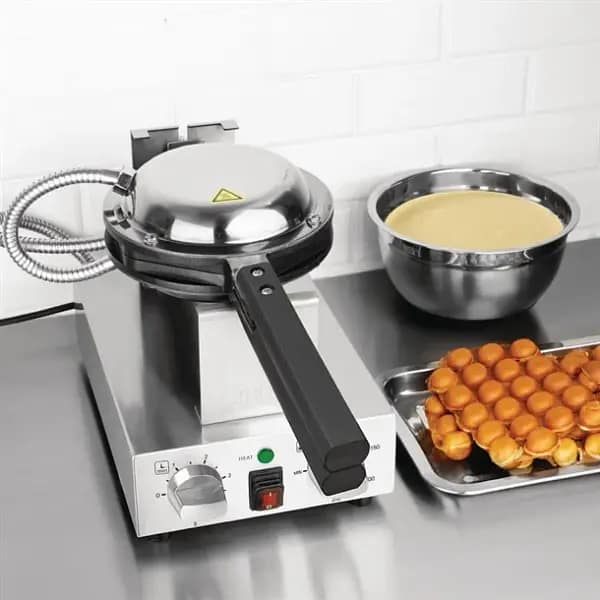Catering Equipment · Australia · 2025
Australia’s 2025 Waffle Maker Guide — Commercial vs Home, Belgian vs Classic, How to Use, Clean, Troubleshoot & ROI
A great waffle maker turns weekend queues into steady smiles and golden grids. This masterclass explains waffle styles (Belgian, classic, Liège and bubble), the machine options you’ll see in Australia (single, double, flip, cast‑iron and non‑stick), realistic plate temperatures and cook times, a step‑by‑step use SOP your staff can follow, daily cleaning and weekly deep‑clean, a practical troubleshooting matrix, and simple energy maths for ROI. Links below jump straight to our stocked Commercial Waffle & Crêpe Makers.
1) Executive summary
Choose the machine that matches your menu and duty: deeper grids for Belgian volume and toppings, cast iron for sugar‑heavy Liège, and flip mechanisms if you want even expansion and colour on premium batters. Most commercial units in Australia are single‑phase with 10 A or 15 A plugs; power inputs commonly range from ~1.5–2.2 kW (single) to ~2.8–3.6 kW (double). Preheat fully (typically 8–15 min to stabilise plates), portion consistently, and avoid opening in the first 90–120 s of a cook. Use lids? Not here—waffles crisp best with steam allowed to vent after release (on a cooling rack, not in a closed box).
2) Waffle styles & which machine you need
“Waffle” covers several traditions. Understanding the style clarifies which plates, temperatures and cycle times work reliably. The table below is an operator’s snapshot; always cross‑check your model manual and your batter formulation.
| Waffle style | Plate geometry | Best plate surface | Typical plate setpoint | Typical cycle time | Throughput/hour* (per cavity) | Best for |
|---|---|---|---|---|---|---|
| Belgian (deep pockets) | Deep grids (8–18 mm pocket) | Cast iron or heavy non‑stick; flip useful | 190–210 °C | 3.0–4.5 min | ~13–20 | Dessert bars, premium toppings, hotels |
| Classic/American | Shallower grids (4–8 mm) | Non‑stick or seasoned cast iron | 180–200 °C | 2.5–3.5 min | ~17–24 | Fast cafés, kid’s menus, high turnover |
| Liège (pearl sugar) | Rounded, thicker dough imprint | Cast iron (sugar‑tolerant) | 185–205 °C | 3.5–5.0 min | ~12–17 | Caramelised crunch; street‑style |
| Bubble (egg waffle) | Bubble plates (flip helps) | Non‑stick | 185–200 °C | 3.0–4.0 min | ~15–20 | Markets, Instagram‑friendly cones |
*Throughput/hour per cavity = 60 ÷ cycle time (minutes). A double machine has two cavities, so double the figure.

3) Machine types & controls
Single vs double vs quad
A single head is ideal for low‑volume cafés or á‑la‑minute service. Doubles suit dessert bars and hotels; quads are specialised and need bench space plus dedicated circuits. Typical Australian plugs: 10 A (standard) and 15 A (higher power). Confirm your outlet and breaker.
Fixed plates vs flip/rotary
Flip mechanisms even out batter spread for deep Belgian grids and can improve colour uniformity. Fixed plates are faster to load/unload and easier to place on compact benches.
Plate materials
- Cast iron — durable, seasonable, loves sugar; needs seasoning and light oil care.
- Non‑stick — fast to start, gentle clean; avoid metal tools; respect coating lifespan.
Controls
Thermostat (dial or digital) + ready lights, and an audible timer are the everyday essentials. High‑end units add shot counters and temperature locks.
| Type | Power (kW) | Preheat to service | Typical cycle | Throughput/hour (per head) | Best for |
|---|---|---|---|---|---|
| Single, fixed, non‑stick | ~1.5–2.0 | ~8–12 min | 2.5–4.0 min | 15–24 | Small cafés, occasional dessert |
| Double, flip, non‑stick | ~2.8–3.6 | ~10–15 min | 3.0–4.0 min | 30–40 | Dessert bars, hotels, steady queues |
| Single, cast iron (Liège) | ~1.6–2.2 | ~10–15 min | 3.5–5.0 min | 12–17 | Sugar‑caramelised waffles, markets |

4) Temperatures, preheat & production planning
Colour and crispness come from plate temperature, dwell time and recipe sugars/fats. Most operators settle between 180–210 °C plate temperature and 2.5–4.5 min cook time, then adjust per batter. Heavier plates hold heat better across rushes; lighter plates recover faster after opening.
Add ~2–3 minutes per tray for demoulding, wiping sugar and resets when forecasting real‑world service.
- Preheat fully until the ready light cycles a few times; log the time for your model (often 8–15 min).
- Don’t peek for the first 90–120 s — opening dumps heat and tears structure.
- Stage to rack (not in closed boxes) to vent steam and hold crispness for plating.
5) Batter & ingredients (crisp vs cakey)
Waffles fry where batter meets plate. Fat, sugar and hydration drive colour and release. A Belgian batter (with yeast or whipped whites) rises into deep grids; a quick batter uses baking powder/soda and tends to cook faster but with a tighter crumb.
Pancake mix in a waffle maker?
Yes — but tweak it. Add fat (butter/oil) and reduce liquid to thicken; aim for a batter that ribbons slowly from a ladle. Expect a lighter colour unless you increase sugar.
Release & seasoning
- Brush a thin layer of high‑smoke‑point oil (don’t spray aerosols near controls).
- For cast iron, season initially with a light oil bake per the manual; maintain with thin films after cleaning.
6) How to use a waffle maker (step‑by‑step)
Opening checks (5–8 minutes)
- Inspect plates are clean, dry and (if cast iron) lightly seasoned.
- Power on; set thermostat to your style (180–210 °C typical); preheat until the ready light cycles.
- Prepare portioning: one ladle or a scale (e.g., ~120–180 g per Belgian plate; adjust to your grid).
- Brush a thin film of release oil. Avoid pooling.
Cooking
- Load batter to fill ~80–90% of the grid. Close calmly; if using a flip, rotate as designed.
- Start the timer; do not open for the first 90–120 s.
- At the cue (e.g., 2.5–4.5 min total), open and release. Add or subtract 15–30 s to tune your colour.
- Stage waffles upright on a wire rack to vent steam and keep the crust crisp.
How long to cook a waffle?
Belgian: ~3.0–4.5 min; Classic: ~2.5–3.5 min; Liège: ~3.5–5.0 min; Bubble: ~3.0–4.0 min.
Ranges depend on plate mass, thermostat accuracy and batter.
7) Daily cleaning & weekly deep‑clean
Daily close (while warm, unplugged)
- Scrape crumbs and sugar with a soft scraper; empty and wash drip trays.
- Wipe plates and surrounds with warm water and a non‑caustic, food‑safe detergent; avoid soaking or flooding.
- Cast iron: dry and brush a very thin oil film to protect seasoning. Non‑stick: no metal pads; rinse and dry.
- Wipe control faces; keep aerosols away. Coil cables loosely; store dry.
Weekly deep‑clean
- Cast iron: remove light carbon with an approved grill stone/nylon pad; re‑season per the manual.
- Check hinges, springs and handles; tighten hardware. Inspect cable/plug for wear; test RCDs where applicable.
- Verify thermostat accuracy with a surface probe, or dial in by consistent colour at a fixed timer.
8) Troubleshooting & safety
| Symptom | Likely cause | Immediate action | Long‑term fix |
|---|---|---|---|
| Waffles stick to plate | Plate not hot; no release; batter too wet; worn non‑stick; cast iron unseasoned | Preheat longer; brush thin oil; thicken batter | Season cast iron; replace worn plates/coating; standardise ladle weight |
| Pale colour at timer | Low temp; short dwell; low sugar/fat | Raise setpoint 5–10 °C; extend 15–30 s | Adjust recipe for sugar/fat; verify thermostat |
| Uneven browning | Not flipping (flip model); bench not level; cold spots | Flip as designed; level machine | Service elements/thermostat; choose heavier plates |
| Burnt sugar smoke (Liège) | Pearl sugar overflow; no wipe between cycles | Scrape/wipe between batches; use drip trays | Cast iron plates; refine dough weight and placement |
| Trips power | Overloaded circuit; damaged cord; moisture | Isolate; dry; reset RCD only once | Electrician check; split loads across circuits |
| Soggy waffles after plating | Trapped steam; boxed too soon | Stage on wire rack 1–2 min | Ventilated packaging; reduce batter hydration |
9) Commercial vs home waffle makers
| Factor | Commercial waffle maker | Home waffle maker |
|---|---|---|
| Plate mass | Heavy (better heat stability) | Lighter (faster cool‑down) |
| Power | Higher kW; 10–15 A plugs common | Lower kW; mostly 10 A |
| Duty cycle | Built for continuous service | Intermittent, household duty |
| Serviceability | Replaceable plates/hinges/thermostats | Limited spares; replace unit |
| When it fits | Any venue selling waffles daily | Occasional specials or home use |

10) Energy maths & ROI
| Scenario | Formula | Example | Result |
|---|---|---|---|
| Energy cost per hour | Cost/h = kW × duty × $/kWh | 2.0 × 0.6 × $0.30 | $0.36 / h |
| Throughput (double, 3.5 min) | Batches/h = 60 ÷ 3.5 × 2 heads | ≈ 34 | ~34 waffles/h |
| Gross margin per waffle | GM = price − (ingredients + energy + disposables) | $8.00 − ($1.70 + $0.01 + $0.20) | $6.09 |
| Payback (months) | Capex ÷ (GM × units/day × 30) | $2,200 ÷ ($6.09 × 40 × 30) | ~3.0 months |
Duty = fraction of time the elements are heating (e.g., 0.6 = 60%). Adjust for your tariff and menu pricing.
11) Brand landscape (neutral view)
In Australia you’ll commonly see commercial waffle makers from brands such as Roband, Apuro, Waring Commercial, Krampouz, Roller Grill and Anvil. Compare plate geometry, power, flip mechanisms, spare parts support and service access. If you plan Liège dough with pearl sugar, favour cast‑iron plates and easy‑clean drip paths.
12) FAQ
How do you make waffles without a waffle maker?
Use a heavy skillet or grill pan, high heat and a thicker batter; you’ll get crisp pancakes, not authentic grid waffles. For volume or deep pockets, you need a waffle iron.
Can you use pancake mix in a waffle maker?
Yes — add fat and reduce liquid; cook longer for colour. Expect less crunch unless you increase sugar and heat.
How long to cook waffles, and at what temperature?
Belgian: ~3.0–4.5 min at ~190–210 °C; Classic: ~2.5–3.5 min at ~180–200 °C; Liège: ~3.5–5.0 min at ~185–205 °C. Tune to your plates and batter.
Cast iron vs non‑stick plates — which is better?
Cast iron is durable, seasonable and handles sugar well; non‑stick is faster to start and easier to clean but requires gentler tools and care with coatings.
Why are my waffles soggy after a few minutes?
Steam trapped in closed containers softens the crust. Stage on a rack to vent for 1–2 minutes; avoid lidded boxes until just before serving.
Do I need a flip (rotary) waffle maker?
For deep Belgian grids and highly aerated batters, flip can improve spread and colour uniformity. For classic shallow grids, a fixed plate is usually fine.
How do I clean a waffle maker safely?
Unplug; scrape crumbs; wipe with warm water + food‑safe detergent. Cast iron: dry and apply a thin oil film. Non‑stick: no metal pads. Never pressure‑wash or flood controls.
13) References (official guidance)
- Food Standards Australia New Zealand (FSANZ) — Food safety: temperature control & the 5–60 °C danger zone (background for hot holding/cooling principles).
- State food authorities (e.g., NSW Food Authority) — guidance on safe food handling and equipment cleaning for cafés and restaurants.
- Manufacturer manuals — plate seasoning and cleaning instructions for your specific model (always follow the manual first).

